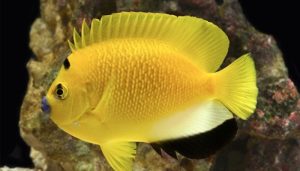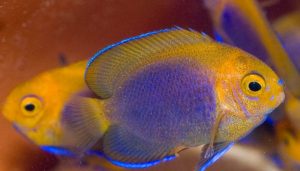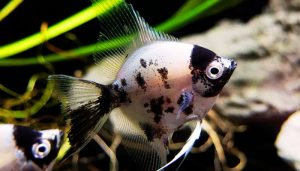Ghost shrimp are an incredibly prolific species of invertebrates, and it’s not uncommon for them to reproduce in home aquariums. You may find yourself overwhelmed if your tank suddenly has a lot of pregnant ghost shrimps. But what are the pregnant ghost shrimp stages?
But don’t worry! You can successfully breed these creatures and ensure their health and well-being with the proper knowledge.
In this blog post, we’ll provide you with all the tips & info you need on the five stages of a ghost shrimp with eggs so that you can have a successful breeding experience!
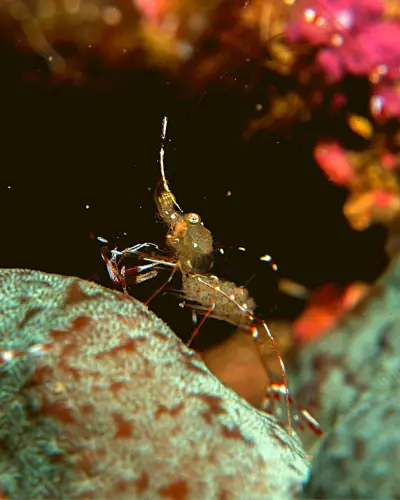
Table of Contents
ToggleHow To Tell if Your Ghost Shrimp Is Pregnant?
What does a pregnant ghost shrimp look like? If you have a ghost shrimp, it’s possible it could be pregnant. Ghost shrimps typically take around two weeks to gestate after mating and can produce up to 100 offspring simultaneously!
how to tell if a ghost shrimp is pregnant? To tell if your mother ghost shrimp is pregnant, you’ll want to look closely for any signs of an egg sac under her tail.
Pregnant ghost shrimp often have a distinctive cluster of opaque white dots and green dots near the end of the ghost shrimp’s abdomen, indicating a clutch of eggs.
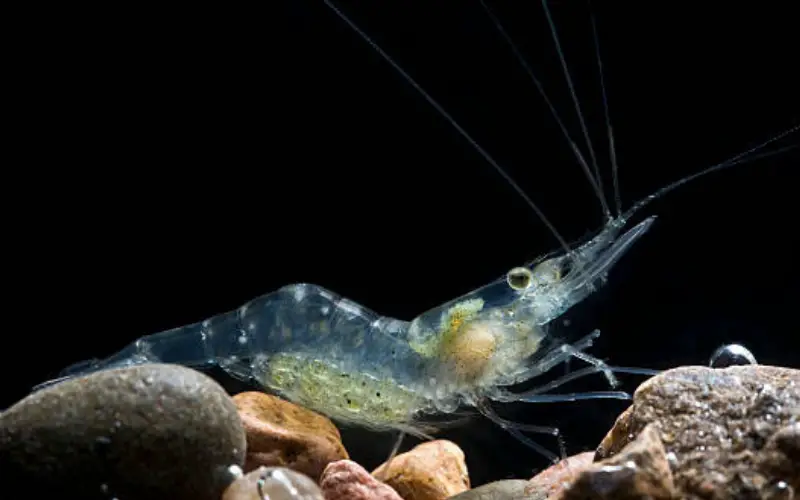
Additionally, female ghost shrimps may fan their legs more than usual when carrying eggs, which helps keep them clean and aerated for optimal incubation.
It’s essential that the water conditions remain stable during this time to ensure successful hatching; check your tank regularly for ammonia levels or other contaminants that can hurt baby shrimps.
With some careful observation and dedication, you should soon know how many babies and if your ghost shrimp is expecting to breed!
Pregnancy Phases for Female Ghost Shrimp
Female shrimps have three distinct phases of pregnancy. These are the pre-egg, egg, and post-egg stages.
- The first, the pre-egg phase, occurs after the female mates with male ghost shrimps, and she carries eggs inside her body. During this time, female shrimp can show increased agitation and behavioral changes as their body prepares for egg production.
- During the Egg Phase, female Shrimp ghosts will begin to produce eggs protected inside an orange-brown leathery shell called a “berried ghost shrimp” or “marsupium,” which will hold up to 30–100 eggs simultaneously, depending on size and species type. This protective outer layer helps protect the developing embryos from predation while they mature until hatching becomes imminent.
- The post-egg phase is when ghost shrimps release their fully developed young into open waters, usually in shallow ponds or streams, where they can swim freely and feed on tiny planktonic organisms like algae before settling into their natural habitats later in life as adults.
Females may carry several batches of berried eggs multiple times throughout their lives—enabling them to reproduce repeatedly!
How Long Are Ghost Shrimp Pregnant for?
How long do ghost shrimp stay pregnant? When the ghost shrimp egg is fertilized, ghost females carry the sperm for around two weeks and flutter green eggs regularly. In the end, the children are born in live larval stages.
During gestation, it takes approximately three full weeks for your Ghost Shrimp to develop after fertilization. Noticeable changes occur in the appearance of the eggs under your female shrimp’s tail as they become more opaque and slightly swollen.
After the eggs hatch, the young ghost shrimp swim in the tank for a few days until they lay on the bottom of the aquarium. You can observe their development and growth as they become more independent.
Overall, the entire ghost shrimp gestation period can range from three to four weeks, depending on the environment and food availability in their tank or aquarium.
How Do You Know When Your Ghost Shrimp Is About to Give Birth?
To tell if a ghost shrimp is about to give Birth, it’s essential to look for physical signs that indicate she is close to releasing her eggs.
These signs may include visible changes in coloration (the abdomen will become increasingly transparent with more prominent black spots), an enlarged abdomen due to the growing ghost shrimp egg mass underneath, and an increase in activity around her fanning tail where she has been gestating the eggs for several weeks before giving birth.
Another sign that your ghost shrimp is about to give birth is noticing newly hatched larvae in the tank or aquarium water surrounding her.
If you can see tiny baby ghost shrimp free swimming around or hatched out of their egg cases near your pregnant shrimp, chances are she has already given birth recently or will be shortly after this time.
This can also happen when you see a female expelling large numbers of free-floating yellowish embryos from her ventral fan – these miniature versions of adult shrimps have come from within and were released during spawning!
Finally, if you want confirmation that your ghost shrimp is pregnant before any other visual cues occur, consider setting up an aquarium light over their tank and observing them overnight. You may notice signs of movement within their body as they get close to laying spawn, which can help provide additional insight into when exactly they might be birthing young soon!
What are the Stages of Ghost Shrimp Pregnancy?
Understanding the stages of shrimp pregnancy is critical to ensuring it reaches total health and well-being. But the shrimp pregnancy stages are often mysterious and hard to identify without extensive research.
Because of this, many shrimp owners have no idea what’s going on until the baby shrimps appear – if they are lucky. It can sometimes be too late for effective intervention when issues do arise.
Here are the stages of a ghost shrimp’s pregnancy:
Female Pregnant Ghost Shrimp Stages
Ghost shrimp go through several distinct stages during the breeding process. Understanding these ghost shrimp pregnant stages is crucial for ensuring the pregnant ghost shrimp’s and her offspring’s health and well-being.
Stage One: Mating Dance
Before the female ghost shrimp becomes pregnant, she engages in a fascinating mating dance with male shrimps. During this male and female courtship ritual, the male ghost shrimp performs intricate movements to attract the female’s attention. Once the female is receptive, the male deposits sperm packets, known as spermatophores, which she stores for fertilization.
Stage Two: Ovulation
Following successful mating, the female ghost shrimp enters the ovulation stage. In this phase, her ovaries release mature eggs, fertilized by the stored sperm packets. The fertilized ghost shrimp eggs are then carried within the female’s abdominal cavity, where they develop and grow.
Stage Three: Berried Female
As the eggs develop inside the female ghost shrimp, her abdomen takes on a distinctive appearance. The eggs resemble small berries or berries on a vine, earning the female the name “berried-out female shrimp.” The eggs are attached to pleopods, small appendages on the underside of the female’s shrimp abdomen.
Stage Four: Incubation
The female ghost shrimp diligently cares for her eggs during the incubation stage. She fans them with her pleopods, ensuring a constant flow of oxygen and removing waste materials. It is crucial to provide optimal water conditions and a well-balanced diet during this stage to support the healthy development of the eggs.
Stage Five: Hatching
After an incubation period of approximately two to three weeks, the fertilized egg hatch, releasing tiny, transparent baby shrimp into the aquarium. These juvenile breed ghost shrimp are fully formed but lack the coloration and size of adult ghost shrimp. It is vital to provide them with ample hiding spots and a suitable diet to increase their chances of survival.
Stage Six: Juvenile Growth
As the baby ghost shrimp grow, they molt periodically, shedding their exoskeletons to accommodate their increasing size. Molting is a vulnerable time for young ghost shrimp breed, as they are more susceptible to predation and other environmental factors. Maintaining stable water conditions and offering a diverse diet is crucial for their healthy growth.
Do Ghost Shrimp Give Live Birth?
Ghost shrimp, also known as Glass Shrimp or sometimes called ‘Crystal Red’ Shrimp, do not give live birth. Instead, the female ghost shrimp lay eggs on patches of live plants, java moss, or rocks and let them hatch there.
The eggs are adhesive, and the female carries them around until they find a suitable place to attach themselves. These egg layers usually produce up to 100 eggs at once, taking approximately six weeks before they hatch into baby ghost shrimp.
How Do Ghost Shrimp Give Birth?
People often don’t know the answer to the question of how ghost shrimps give Birth. Understanding the process is essential for adequately caring for pregnant ghost shrimp and may have implications for other species in the aquarium.
Answer this perplexing question by watching our video about pregnant and ghost shrimp, which explains these fascinating creatures’ behavior and reproductive habits. Learn more about them today and better understand their natural behavior.
TOP 5 Tips for Successful Breeding
- Water Conditions: Maintain a stable and clean environment for your ghost shrimp. Ideal water parameters include a water temperature of 70-80°F (21-27°C), a pH of 7.0-8.0, and low ammonia, nitrite, and nitrate levels.
- Diet: Provide a varied and balanced diet for your ghost shrimp. This can include high-quality shrimp pellets, blanched vegetables, algae wafers, and occasional live or frozen foods such as brine shrimp or daphnia.
- Hiding Spots: Provide plenty of hiding spots for your ghost shrimp, such as plants, rocks, and driftwood. This will help them feel secure and help reduce stress during breeding.
- Separate Breeding Tank: Set up a separate breeding tank for your pregnant ghost shrimp to avoid predation by other tank inhabitants. This will also make monitoring the development of the eggs and larvae easier.
- Larval Care: Feed the ghost shrimp larvae a diet of phytoplankton or infusoria and gradually introduce them to more significant foods as they grow. Be sure to maintain good water quality in the larval tank, as the larvae can be sensitive to poor water conditions.
By following these vital guidelines, you can ensure that your fish lays good quality eggs and enjoy watching the fascinating process of their development from eggs to adult shrimp.
How Long Does it Take Ghost Shrimps to Give Birth?
how long do ghost shrimp eggs take to hatch? A female ghost shrimp typically takes two to three weeks to give Birth. During this time, the eggs need to incubate in warm water at optimal temperatures of 70-80°F (21-27°C) for the best chances of survival.
After hatching, the larvae will molt several times in the first few weeks and grow to the size of an adult ghost shrimp. The total time from egg to adult can take up to nine weeks, depending on the water conditions, diet, and other environmental factors.
What Happens When a Ghost Shrimp Gives Birth?
When a ghost shrimp gives Birth, the female will lay up to 20-30 eggs in one clutch. These eggs are usually attached to a plant or the bottom of the tank and will hatch into tiny larvae within a few days.
The newly hatched larvae are tiny and can only be seen with a magnifying glass. They need good water quality, food, and hiding spots to survive. After several molts, the larvae will grow and become adult ghost shrimps.
It is essential to remove the ghost shrimp eggs or larvae from the community tank if possible, as they can be eaten by other tank inhabitants or suffer from poor water quality. A separate breeding tank is recommended for successful ghost shrimp breeding.
How Many Eggs Can Ghost Shrimp Carry Per Pregnancy?
How many babies do ghost shrimp have? A pregnant female ghost shrimp can carry 8 to 85 eggs. However, not all eggs are likely to survive through the birthing process.
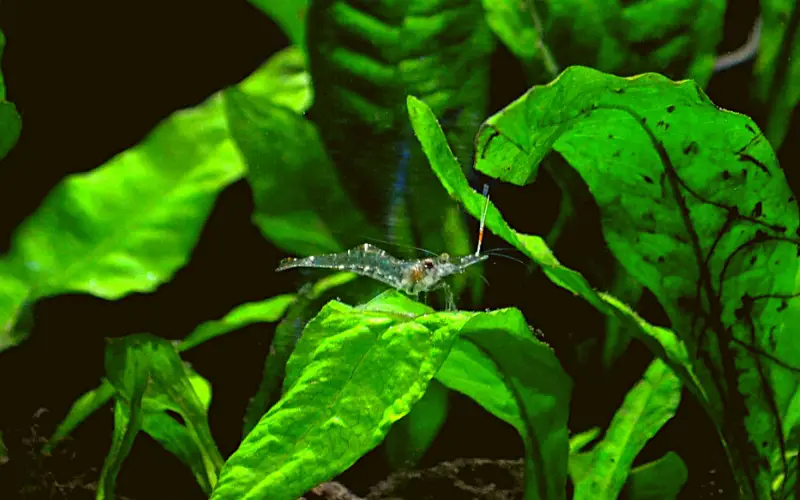
A female ghost shrimp typically lays about 20-30 eggs in one clutch. The shrimp eggs will hatch within a few days, and the larval stage will take up to 8 weeks to reach adulthood.
By providing the ideal conditions for breeding, such as a separate breeding tank with optimal water parameters and a balanced diet, plenty of hiding spots, and a varied diet, you can help increase the chances of successful breeding. Careful monitoring is also vital to properly care for the eggs and larvae.
An adult Ghost Shrimp can live up to 2 years if provided with optimal conditions. If the water parameters are maintained at appropriate levels and the diet is balanced, Ghost Shrimp can live a long and healthy life.
Should You Separate a Pregnant Ghost Shrimp from the Main tank?
Once the female ghost shrimp laying eggs, removing them from breeding areas will be advised. The eggs can be removed in a community tank without danger, but the pregnant ghost shrimp can be removed much faster than the 20-30 egg-size pinheads.
Another risk to leaving ghost shrimp larvae in community tanks is that others can eat eggs or ghost shrimp fry. I suggest storing the shrimp in another breeding tank before the baby ghost shrimps get big enough for adoption into the community tank. Recommendations.
Baby Ghost Shrimp Care and Feeding
How do we keep our 20-30 eggs healthy? Luckily that’s how you built the container for a new shrimp. The breeding tank you set up and cycled during the first phase could provide a nursery for the shrimps.
If the hatchling makes much more waste than eggs, you may need more changes to your water system. Feeding ghost shrimp babies is the most straightforward aspect because they’re so small. In the early weeks, our doctor suggests soft vegetables.
For the first weeks, you can also feed your baby ghost shrimp natural food like Daphnia or Cyclops. When it grows, you can provide them with some more significant foods.
You may increase your shrimp babies’ growth rate if you feed them a variety of natural food sources. As the shrimp grows older, ghost shrimps eat sinking pellets, liquid newborn ghost shrimp food, algae powder, sinking wafers, and flakes.
Finally, the water parameters should remain optimal for the health and growth of the newborn shrimp. The temperature should be kept between 68-78 degrees Fahrenheit, with a pH level of
Ghost Shrimp Giving Birth FAQs (Frequently Asked Questions about newborn ghost shrimp)
How Long Does the Ghost Shrimp Breeding Process Take?
How long do ghost shrimp carry eggs? The breeding process, from mating to ghost shrimp eggs hatching, typically takes four to six weeks.
Can I Keep a Pregnant Ghost Shrimp in a Community Tank?
Yes, pregnant shrimp in fish tank can coexist with other peaceful tank mates. However, avoid housing them with aggressive species of other fish that may harm the berried female or her offspring.
How Can I Tell If Ghost Shrimp Is Pregnant?
Look for a distinct berry-like appearance on the female’s abdomen. The presence of eggs attached to the pleopods indicates that the ghost shrimp is pregnant.
What Should I Feed My Pregnant Ghost Shrimp?
Provide a varied diet consisting of high-quality fish flakes, pellets, algae wafers, and blanched vegetables like spinach or zucchini. To ensure optimal nutrition, supplement their diet with tiny frozen or live foods, such as baby brine shrimp or daphnia.
How Many Eggs Can a Pregnant Ghost Shrimp Carry?
A pregnant ghost shrimp can carry anywhere from 20 to 30 eggs, depending on size and health.
Should I Remove the Berried Female from the Main Tank?
Removing the berried female is only necessary if you have aggressive tank mates or specific breeding requirements. Feeder shrimp are generally good parents and will diligently care for their eggs and offspring.
Do Ghost Shrimp Die After Laying Eggs?
No, Ghost Shrimp do not die after laying eggs. If provided with the proper water conditions and diet, Ghost Shrimp can live for up to two years. However, their lifespan will be significantly shortened if they are bred frequently due to the stress of carrying and laying eggs.
What do ghost shrimp eggs look like?
Ghost shrimp eggs are tiny, oval-shaped, and dark colored, usually appearing black or very dark green. They’re carried attached to the female’s swimmerets until hatching.
What do baby ghost shrimp look like?
Newborn ghost shrimp are nearly transparent, miniature versions of the adults. Very small, only a few millimeters long, they may be hard to spot without close inspection.
Do ghost shrimp lay eggs?
No, ghost shrimp don’t lay eggs externally. Instead, females carry fertilized eggs attached to their swimmerets until they hatch. These appear as green clumps under her tail.
Where do ghost shrimp lay eggs?
Ghost shrimp don’t lay eggs externally. Instead, females carry fertilized eggs attached to their swimmerets under their tails. These appear as green clusters.
Will pregnant ghost shrimp giving birth or lay eggs?
Ghost shrimp lay eggs! You’ll see them as a green cluster under her tail. They hatch into tiny larvae after a few weeks.
Should I separate pregnant shrimp?
It usually depends on your tank setup. If the tank has plenty of hiding spots and no fish that eat shrimp, separating the pregnant shrimp isn’t necessary.
Final Thoughts
So, what does a pregnant shrimp look like? Breeding ghost shrimp can be an exciting and rewarding endeavor for aquarium enthusiasts. By understanding the various stages involved in the breeding process, you can provide the necessary care and support for your pregnant ghost shrimp and their offspring. Remember to create a suitable environment, maintain stable water conditions, and provide a nutritious diet. With patience and attention, you can witness the remarkable journey from mating to hatching as your ghost shrimp population grows.
how to care for pregnant ghost shrimp? In conclusion, this comprehensive ghost shrimp breeding tank guide has provided valuable insights into the pregnant shrimp stages. From the intricate mating dance to the development of eggs and the hatching of baby shrimp, each stage plays a vital role in successfully breeding ghost shrimp. Following the vital tips and guidelines outlined in this guide can enhance your chances of breeding healthy and thriving ghost shrimp in your aquarium.
You might also like
- Life Span of Ghost Shrimp 101: Excellent Tips You Can’t-Miss
- Ghost Shrimp Pregnancy Care, Signs, Stages, And More!
- What Does Ghost Shrimp Eat: Top 5 Foods For Optimal Health
- Does Ghost Shrimp Eat Algae: Let’s Clear Up All the Confusion!
- Shrimp Ghost Care 101: Some Excellent Facts You Can’t-Miss!
- Care for Ghost Shrimp 101: Ultimate Guide & Breeding Tips
- How Long Does Ghost Shrimp Live: (Prolong Their Lifespan)
- Breeding Ghost Shrimp: Unlock the Secrets of Successful Raising
- Ghost Shrimp Eggs hatching: 5 Simple Tips for (Successful Hatching)
- How Often Do Glass Shrimp Breed: (A Comprehensive Guide)
- Ghost Shrimp Vs Whisker Shrimp: the Winner Will Surprise You!
- How to Breed Freshwater Ghost Shrimp: 5 Proven Tips for Maximum Profit!


